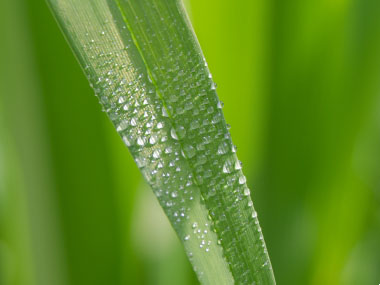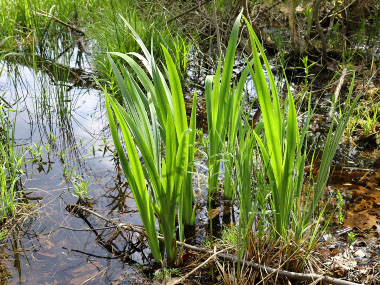





To support our efforts please browse our store (books with health benefits, etc.).
Sweet Flag is a perennial wetland plant that grows in colonies. At a distant they resemble cattails, and wild iris. When examining close up, the spadix (finger-like flower head) can be found hidden in the leaves, then it is easy to identify. There are two species of Acorus in Canada and the U.S. Acorus calamus, introduced from Europe and Asia, and Acorus americanus, the native Sweet Flag. Some people report that it is almost impossible to tell the two apart but supposedly the native species has distinct ribs that run parallel on the leaf blades. DNA evidence supports Acorus species as the oldest surviving line of monocots. Sweet Flag spreads vegetatively by its rhizomes and generally forms colonies.
Distinguishing Features
The spadix (the flower) is a very distinct feature of this wetland plant, although they are only in bloom for about a month. The bright green sword-shaped leaves have a very nice fragrant scent when they are cut or broken as to the roots as well. Sweet Flag leaf blades tend to be greener than irises.
Flowers
The flowerhead is known as a spadix. Tiny yellowish to brownish flowers form a diamond-shaped pattern and envelope a cylindrical, finger-like head. Each flower has six tepals and six stamens. The spadix can measure anywhere from 3cm (1.5") to 10cm (4"); typically, it is 10cm or slightly larger. This flower protrudes from the middle of a green stiff. (This is an erect, leaf-like spathe.) The blooming period occurs from late spring to early summer and lasts about a month.`
 Fields
of Nutrition has medicinal benefits and vitamin/mineral content of Sweet Flag.
Fields
of Nutrition has medicinal benefits and vitamin/mineral content of Sweet Flag.
Leaves
Leaves are flat on one side more than the other and resemble the sword shape. The leaf blade margins are smooth and have parallel veins. Often, there is an off-center ridge or indentation along the length of each leaf. Some leaves form a spadix. They typically grow anywhere from 60cm to 1 meter (2 to 3 feet) long and measure about 1.25cm (1/2") wide. The base of leaves are typically white or tinged red. Leaves are sweetly fragrant when broken.
Height
Sweet Flag can be as short as 30cm (1') but can reach heights more than 1 meter (3').
Habitat
This is a wetland plant, so it is found along marshes, ponds, and lakes typically in calm water. It can also be found along swamps and other waterways. It grows throughout Canada, and the northern half of the U.S. Although is mostly grows in sunny locations, it also likes part shade conditions.
Edible Parts
The root (rhizome) was used in many ways. It has a flavor that is close to cinnamon, so it is commonly used as a replacement for that spice. Some people will candy the rhizome. The root is rich in starch, and it also contains a bitter glycoside, so caution is advised to test this plant via the universal edibility test first, and even if you are ok with this, small amounts only.
Other Name
Sweet Rush.
Similar Plants
Iris.
Winter Survival Food Handbook

PDF Plant Magazines
Types of Wild Food
Geographic Zones Seasons
Disclaimer
EdibleWildFood.com is informational in nature. While we strive to be 100% accurate, it is solely up to the reader to ensure proper plant identification. Some wild plants are poisonous or can have serious adverse health effects.
We are not health professionals, medical doctors, nor are we nutritionists. It is up to the reader to verify nutritional information and health benefits with qualified professionals for all edible plants listed in this web site. Please click here for more information.
Why Edible Wild Food?
- Food costs are rising
- Free, wild food is readily abundant
- Wild food adds nutrition to your diet
- Wild food can help treat various medical conditions





